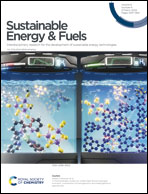Potential application of ternary pentagonal p-SiXY4 (X = Si, C, Ge; Y = C, B, N) materials for optoelectronics and photocatalytic water splitting: a first-principles study
Abstract
Recently, two-dimensional (2D) materials with a pentagonal structure have attracted great interest since the discovery of penta-graphene, due to their unique structures and remarkable physical properties. In this work, the geometric structure, stability, electronic and optical properties and photocatalytic performances of p-SiXY4 (X = Si, C, Ge; Y = C, B, N) pentagonal materials were systematically examined using first-principles calculations. By assessing the stability, we have found that six of the nine studied p-SiXY4 2D materials have excellent energetic, dynamic, and thermal stability. Electronic structures reveal that these six monolayers have a semiconductor state, with indirect band gaps ranging from 1.39 to 5.45 eV depending on the functional used, which covers the visible-ultraviolet regions. Furthermore, the band edge positions of these pentagonal monolayers perfectly meet the redox potentials for photocatalytic water splitting. The calculated optical absorption showed that p-Si2N4, p-SiCN4 and p-SiGeN4 monolayers exhibit substantial optical absorption in the ultraviolet (UV) range, whereas p-Si2C4, p-SiGeC4, and p-SiCC4 monolayers show a very high optical absorption in the visible and ultraviolet regions (up to 10−5 cm−1). Our finding provides a route to design new Si-based 2D pentagonal materials with excellent application prospects such as in photocatalytic water splitting and optoelectronics.



 Please wait while we load your content...
Please wait while we load your content...